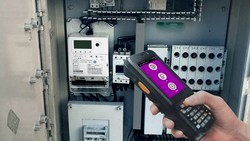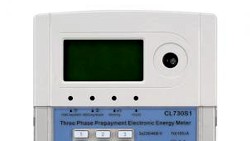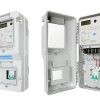Note: since IEC62052-11 Ed.2 the name for the internal relay is supply control switch (SCS).
Usually in electricity meters the load switch is a latching relay.
A latching relay keeps its contact position indefinitely without power applied to the coil. The advantage is that the coil consumes power only for an instant moment while the relay is being switched, and the relay contacts retain this setting across a power outage.
It is located between the supply input and load output terminals of the energy meter.
The relay is able to make, carry and break all values of currents between the minimum switched current rating to the rated breaking current for all values of the rated operating voltage range and the specified operating temperature range of the meter.
For prepayment meters (see also IEC 62055-31)
The rated breaking current (Ic) shall be equal to Imax of the payment meter.
The minimum switched current shall be equal to the nominal starting current of the payment
meter.
The rated breaking voltage (Uc) shall be equal to the upper limit of the extended operating voltage range of the payment meter.
The load switches have different categories for utilization. (UC = Utilization Category)
The payment meter load switching utilization category is subject to the purchase agreement between the payment meter supplier and the purchaser and shall be marked on the label of the payment meter as UC1, UC2, UC3, or UC4.
UC1
Category UC1 is applicable to payment meters rated at maximum currents up to 100 A. There is no requirement for the load switch to also switch the neutral circuit. The short time overcurrent is acc. to IEC 62053-21 for meters for direct connection (30* Imax for half cycle).
Payment meters with load switching category UC2, UC3 or UC4 shall have the following properties:
a) capable of making and breaking negligible currents of specified values
b) capable of making, breaking and carrying rated currents of specified values
c) capable of making into fault currents with specified value and under specified conditions
d) capable of carrying short-circuit currents of specified value for a specified time period and under specified conditions
e) not required to provide safety isolation properties in the open contact position. These are requirements for the installation mains isolation switch
f) not required to break overload currents or short-circuit currents. These are requirements for fuses and circuit breakers that are normally used to protect the installation.
| Test | UC2 | UC3 | UC4 |
|---|---|---|---|
| Fault current making capacity, C.5 | 2.5 kA | 3 kA | 4.5 kA |
| Short-circuit current, C.6 test 1 | 4,5 kA | 6 kA | 10 kA |
| Short-circuit current, C.6 test 2 | 2.5 kA | 3 kA | 4,5 kA |
For detailed information refer to IEC 62055-31, annex C.
Thank you for reading.
Editor's note: This article was originally published in October 2019 and has been updated for comprehensiveness.





Hi Laoren,
does IEC62011-2020 give different definition of UC1, UC2, UC3 and UC4 and their testing requirements to what was described in IEC62052-31, please?
Hello Phillip, thank you for the question. IEC 62011:2020 does not provide definitions or testing requirements for the utilization categories (UC1, UC2, UC3, UC4). It only focuses on the marking and documentation requirements for meters with supply control switch (SCS), as mentioned in table 7 of the standard. The definitions and testing requirements for the utilization categories are specified in IEC 62052-31.
for main relay/contactor inside every prepayment meter, that will open if we are out of credit, is that LCS or SCS?
The relevant standard for prepaid meters IEC62055-31 is relative old (2005). There is still stated the term 'load switch'. For smart meters with disconnect function, we can find both types (SCS = supply control switch #3.2.24 and LCS = load control switch #3.2.25), see IEC62011-2020. I suppose that the term 'load switch' for prepaid meters will soon be updated to LCS. The difference is marginal, but I haven't seen prepaid meters with external relay or manual operation.
What is the difference between LCS and SCS
Since the edition 2 of the IEC62052-11 was published in year 2020, the terms are more specific:
SCS means supply control switch. These switches are internal, build into the meter.
LCS means load control switch. These switches are external to the meter.
(see IEC62052-11 Ed.2, #3.2.24 and #3.2.25)
If the alarm/comm and credit indicator aren't blinking but red always what could be the probrem
It means the meter relay has switched off if the alarm indicator keeps in red. For credit indicator, several suggestions are provided, you can read this article for more details. If still not work, please ask your local power company for a specific solution.
How Clou verify that load control switches satisfy the IEC 62052-31 requeriments?
A load switch is a sub-supplier component.
We are ISO-certified. Part of the ISO process are regular supplier audits.
The verification is based on the provided specifications and type-test reports from our suppliers.
In addition, we are doing lifetime cycle tests on sample base in our laboratory.
The type test certification body (e.g. KEMA) reviews the given documentation during meter type test.
That's the general process in brief, also valid for other 3rd party key components.
After power outage my meter showing load switch open. How can I reset
For CLOU meters it's 00 (enter).
How to generate aclear tamper magic random time short token
I suggest you read more here. Make sure that you understand the article.
Does hexing ciu can load token on another hexing meter
Sure, but I don't know the pairing code for Hexing meters.
Pairing code for hexing HXE12 meters 18075773902 enter. Enter Hexing meter number. Done!
Can anhemeter load token to cl710
The Inhemeter CIU can not charge a CLOU meter.
What is the code use to move the meter from on relay
There is no code for relay operation.